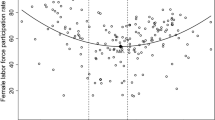Abstract
This paper interrogates the Indian State’s agenda of ‘Doing Development’ with a specific emphasis on how the particular manner in which ‘development has been/is being done’ is having an impact on women’s work and on women as workers. The paper is also aimed at illustrating how the State attempts to kill several birds with one stone; one, in the guise of alleviating poverty, and, two, on the increasingly questionable assumption of poverty being feminised, the State has instituted several welfare programmes that have led to feminisation of responsibilities; again, in the guise of ‘empowering’ women, the State gainfully employs local women but does not designate them as workers. The paper applies existing feminist literature that has critiqued the ‘smart economics’ (Chant and Sweetman 2012) approach that makes women work for development, rather than development enabling women to procure ‘decent’ employment. As illustrations of these attempts, we critically engage with: (a) the Accredited Social Health Activist (ASHA) programmes by juxtaposing official-speak on the subject with studies that examine its functioning on the ground; (b) a critical reading of the institution of para-teachers; and (c) studies that have assessed not just conditions but also the position of anganwadi, paid domestic, and mid-day meal workers as part of the larger developmental efforts of the State. This exercise enables us to discuss the gendered consequences of the above nature of ‘doing development through gender’. It provides concrete illustrations of how, at least in the social sectors, and particularly when it relates to female employment, the traditional hypothesis that the informal sector is a transient phenomenon and would disappear by getting absorbed in the formal sector over the years does not hold true. The informal nature of employment in the social sector has been formalised in several ways, such that while services are being delivered under the formal health/education sector, some of the personnel (mainly women) employed to deliver these services are informally employed within the same sector.
Similar content being viewed by others
References
Bhatia, K. (2014), “Performance-based Incentives of the ASHA Scheme: Stakeholders’ Perspectives”, Economic and Political Weekly, Vol. XLIX, No. 22, 31 May, pp. 145–151.
Chant, S. (2008), “The ‘Feminisation of Poverty’ and the ‘Feminisation’ of Anti-Poverty Programmes: Room for Revision?”, The Journal of Development Studies, Vol. 44, No. 2, pp. 165–197.
Chant, S. and C. Sweetman (2012), “Fixing Women or Fixing the World? ‘Smart Economics’, Efficiency Approaches and Gender Equality in Development”, Gender and Development, Vol. 20, No. 3, November, pp. 517–529.
Chen, M. (1989), “A Sectoral Approach to Promoting Women’s Work: Lessons from India”, World Development, Vol. 17, No. 7, pp. 1007–1016.
Ciotti, M. (2010), “The Burgeois Woman and the Half-Naked One’: Or the Indian Nation’s Contradictions Personified”, Modern Asian Studies, Vol. 44, No. 4, July, pp. 785–815.
Deutsch, F.M. (2007), “Undoing Gender”, Gender and Society, Vol. 21, No. 1, February, pp. 106–127.
Ghosh, B. (2011), “Early Marriage of Girls in Contemporary Bengal: A Field View”, Social Change, Vol. 41, No. 1, pp. 41–61.
Gjostein, D.K. (2014), “A Veiled Change Agent: The ‘Accredited Social Health Activist’ in Rural Rajasthan”, in K.B. Nielsen A. and A. Waldrop (eds.), Women, Gender and Everyday Social Transformation in India, Anthem Press, UK and USA, pp. 139–156.
Govinda, R. and Y. Josephine (2004), “Para Teachers in India: A Review”, International Institute of Educational Planning, UNESCO, Paris, October.
Kingdon, G. and V. Sipahimalani-Rao 2010. Para-Teachers in India: Status and Impact”, Economic and Political Weekly, Vol. XLV, No. 12, 20 March, pp. 59–67.
Palriwala, R. and N. Neetha (2010), “Care Arrangements and Bargains: Anganwadi and Paid Domestic Workers in India”, International Labour Review, Vol. 149, No. 4, pp. 511–527.
Risman, B. J. (2009), “From Doing to Undoing Gender: Gender as We Know It”, Gender and Society, Vol. 23, No. 1, February, pp. 81–84.
Swaminathan, P., J. Jeyaranjan, R. Sreenivasan and K. Jayashree (2004), “Tamil Nadu’s Midday Meal Scheme: Where Assumed Benefits Score Over Hard Data”, Economic and Political Weekly, Vol. 39, No. 44, 30 October, pp. 4811–4821.
Still, C. (2011), “Spoiled Brides and the Fear of Education: Honour and Social Mobility among Dalits in South India”, Modern Asian Studies, Vol. 45, No. 5, September, pp. 1119–1146.
West, C. and S. Fenstermaker (1995), “Doing Difference”, Gender and Society, Vol. 9, No. 1, February, pp. 8–37.
West, C. and D.H. Zimmerman (1987), “Doing Gender”, Gender and Society, Vol. 1, No. 2, pp. 125–151.
Author information
Authors and Affiliations
Corresponding author
Rights and permissions
About this article
Cite this article
Swaminathan, P. The formal creation of informality, and therefore, gender injustice: illustrations from India’s social sector. Ind. J. Labour Econ. 58, 23–42 (2015). https://doi.org/10.1007/s41027-015-0006-z
Published:
Issue Date:
DOI: https://doi.org/10.1007/s41027-015-0006-z




